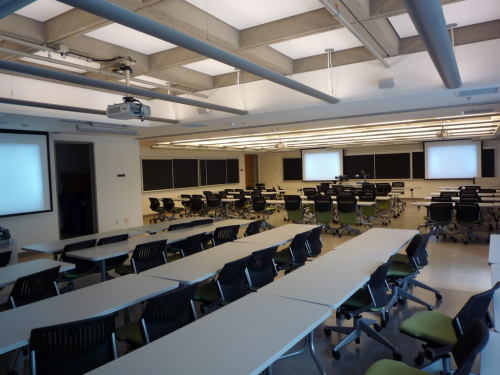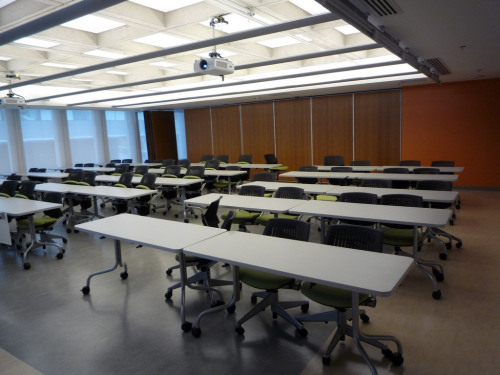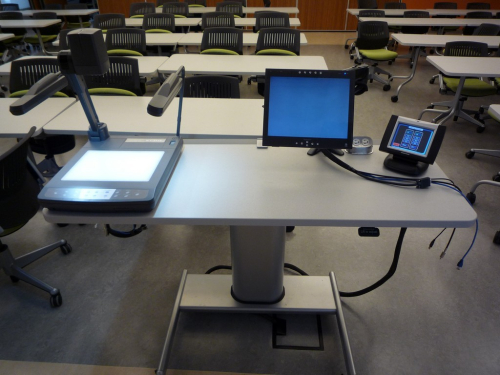- Location: 3644 Peel Street, Montreal, QC
- Capacity: 60 students and 28 students, separated by a moveable wall
- Type: Flat classroom
Alignment with principles for designing Teaching and Learning Spaces
Academic challenge
Promote individual, active engagement with content.
Layout
Substantial work surfaces for notebooks, laptops, and textbooks
Acoustics: Design includes to avoid distraction from outside and inside noise sources.
Furniture
Comfortable chairs on wheels permit students to work individually or in groups.
Technologies
Access to resources: LMS, internet (via student laptops). Multiple sources and screens for simultaneous display of different learning materials.
Lighting & colour
Appropriate lighting for individual work. Intentional use of colour (on chairs) to enliven the space.

Learning with peers
Promote active engagement with one another.
Layout
Flexible layout permits students to move easily from small group to larger group activities.
Acoustics: Sound zones support multiple simultaneous conversations among students.
Furniture
Chairs on wheels permit students to turn and discuss with those nearby. Lightweight chairs and tables on wheels allow for easy reconfiguration of the classroom to support a variety of collaborative learning approaches.
Technologies
Blackboards wrap around three walls of the room, providing ample shared workspace for student brainstorming, work projects, and presenting.
Lighting & colour
New lighting fixtures provide pleasant lighting and windows bring in natural light.

Experiences with faculty
Promote interaction and communication.
Layout
Instructor is not limited to the “front of the room” and instead has access to all students due to easily mobile furniture, which can be set up in multiple configurations according to the pedagogical activity and goals. Further, a movable wall between the classrooms allows larger classes (up to 88 students) to use the space.
Acoustics: Sounds zones ensure that not only are students able to hear the instructor, but that the instructor is also able to hear the students. A wireless microphone is available if needed.
Furniture
An unobtrusive podium does not interfere with sightlines or movement, while still being large enough for all instructional materials. Mobile furniture supports different teaching strategies.
Technologies
Multiple projecting surfaces and dual-source projecting permit the display of different learning materials at the same time (e.g. from the instructor's laptop and the podium PC).
Lighting & colour
Multiple classroom technology sources (document camera, data projector, computer, etc.) permit display of different learning materials. Lecture recording (rm. 312) permits students to review their in-class experience at any time.

Contributions to the campus environment
Classrooms that incorporate elements of active and collaborative learning are part of a vision for a variety of flexible campus learning spaces. These classrooms are designed for all populations using the space: well-lit, with a standardized room control panel that simplifies instructors’ use of equipment in classrooms across campus. IT is consistent with teaching and learning needs, and durable furniture contributes to sustainability efforts. Both physical and virtual affordances help maximize High Impact Practices (HIPs) for student learning within and beyond this classroom.
